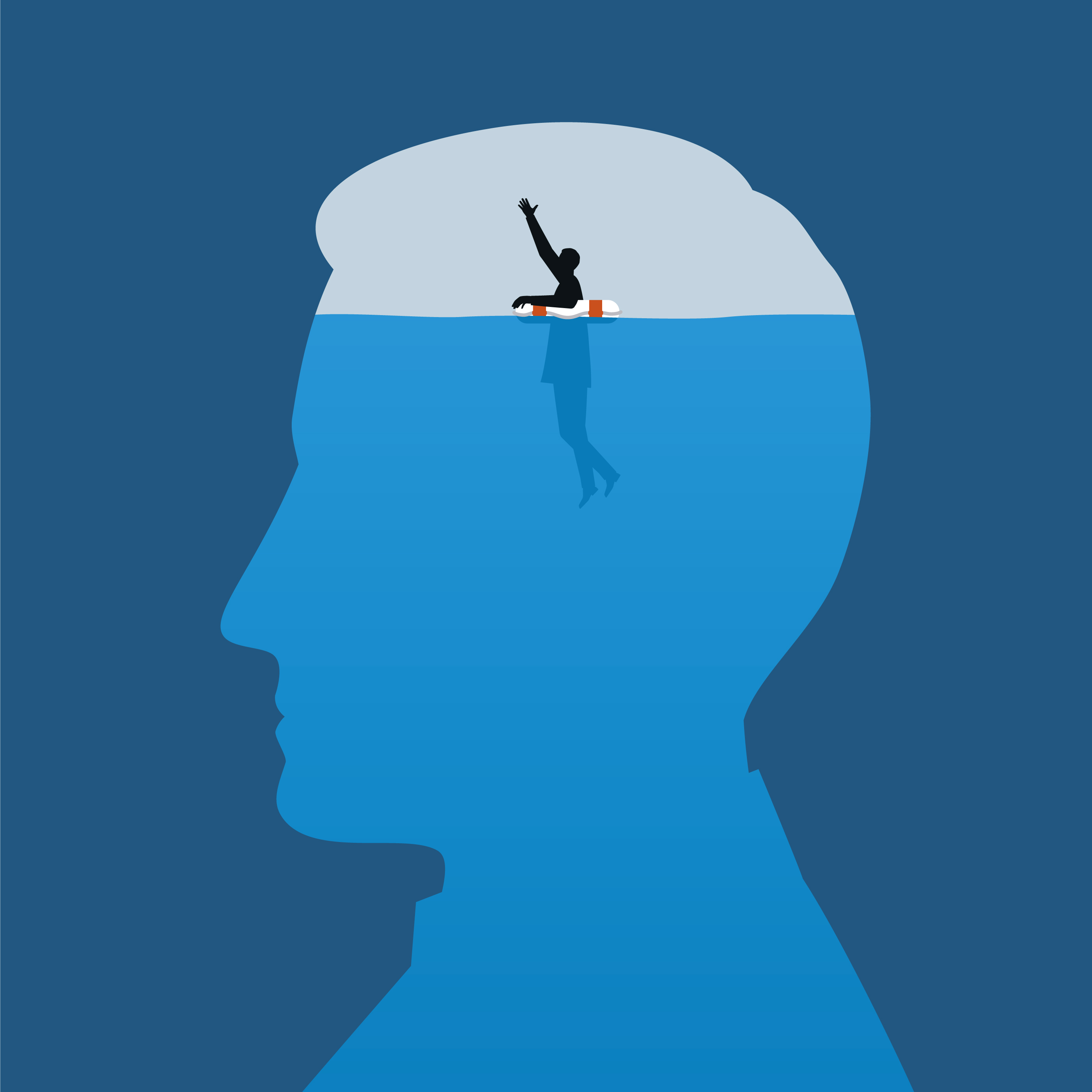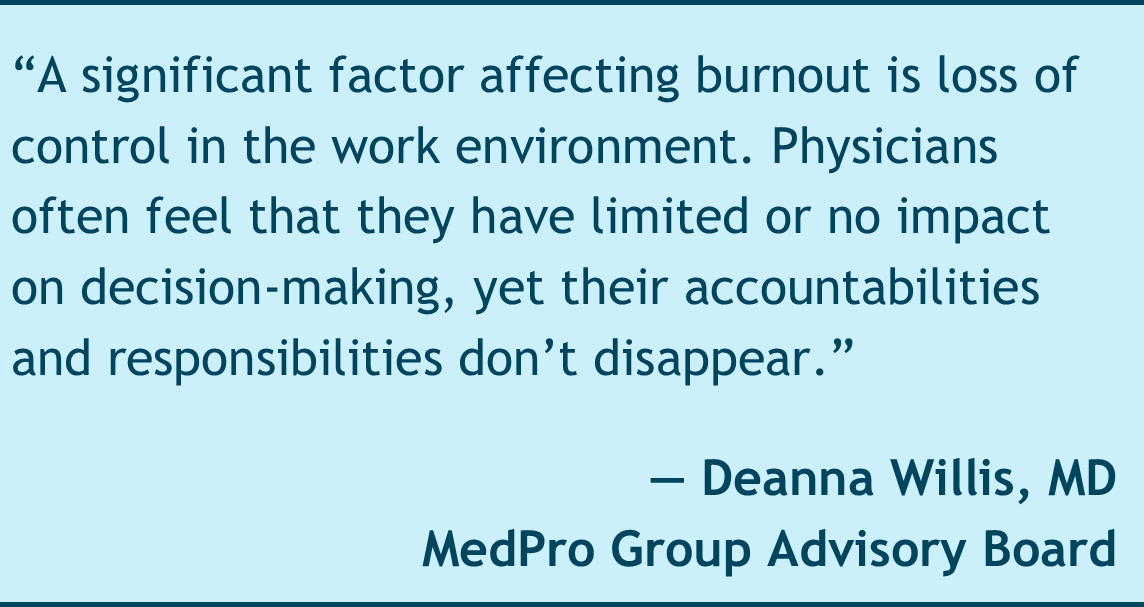Feeling the Burn? 10 Ways Healthcare Providers Can Proactively Address Burnout
Laura M. Cascella, MA, CPHRM
Burnout in healthcare is rampant, and it is not limited to one clinical setting or a particular type of provider. Rather, feelings of exhaustion, cynicism, pessimism, detachment, and ineffectiveness can take a grip on healthcare providers of various ages, backgrounds, and specialties and have far-reaching consequences.
The factors that contribute to burnout — much like its symptoms and outcomes — are wide-ranging and vary for individuals. At a broad level, contributing factors include inefficient workflows, suboptimal technology, increasing regulations, healthcare provider shortages, heavy workloads, loss of autonomy, and shifting values. The consensus view is that burnout is triggered by decisions and factors that mostly are beyond healthcare providers' control and often conflict with their values and moral code. "Regulatory and institutional policies, payer requirements, and intrusive, difficult technologies all challenge the basic ethical motivations that are essential to professional fulfillment of the human beings who are central to high-quality patient care."1
Although healthcare providers might feel helpless to effect change on the macro level required to significantly diminish burnout, research suggests that self-care and individual efforts to address burnout and promote wellness are an essential part of an overall strategy for tackling this pervasive problem. As a NEJM Catalyst report on burnout explains, "Clinicians cannot resolve these complex issues on their own, but neither are they helpless victims. Until structural changes are deployed, individual mitigation strategies can be effective."2
Below are 10 strategies and recommendations for healthcare providers to consider as part of their individual approaches for tackling burnout. Although this list is not all-inclusive or designed to provide a "one-size-fits-all" solution, the recommendations can help practitioners proactively establish a plan of action for improving personal well-being and reducing the detrimental effects of burnout.
- Consider the basic components of a healthy lifestyle — such as diet/nutrition, physical activity, and sleep patterns — and how you're managing in each area. Determine whether adjustments can help improve your overall physical and mental well-being. Changes do not necessarily need to be significant or immediate; incremental changes can have a significant and lasting impact.
- Commit to following through with routine healthcare screenings and exams and seeking care for physical and mental health concerns that arise. Take stock of whether symptoms associated with burnout are leading to increased dependency on alcohol or prescription/nonprescription drugs and seek help to address these issues.
- Learn techniques and methods that encourage relaxation, decrease stress, and improve mental and physical well-being. Examples of these activities include yoga, tai chi, deep breathing, journaling, and meditation. If these traditional stress-relieving strategies aren't helpful, consider other alternatives. For some people, high-impact activities or hobbies might help relieve stress better than low-impact pursuits.
- Participate in wellness initiatives and peer support programs within your practice setting; if none exist, consider starting a committee or program that focuses on improving wellness and resiliency. Small practices with fewer resources might want to consider designating wellness champions who promote resources to improve well-being, model wellness behaviors, and encourage other employees to address issues associated with burnout.
- Work on establishing reasonable boundaries related to personal and professional expectations and commitments, including learning negotiation strategies and recognizing limitations. Recognize personal habits and professional influences that disrupt work–life balance and develop strategies for managing them (for example, not checking work email while vacationing or not spending excessive time discussing or focusing on work during personal or family time).
- Consider initiating or participating in discussions with organizational leaders and decision-makers about work-related strategies to address burnout, such as flexible scheduling, use of support staff, outsourcing of administrative tasks, technology improvements, and other methods to reduce workload burdens and workflow inefficiencies.
- Support efforts to enhance team-building and communication within your practice setting through in-person meetings, huddles, social networking, and collaborative care. Increased interaction and collaboration can facilitate learning, promote shared responsibility, foster a supportive environment, and strengthen connections with colleagues.
- Take time to focus on the purpose and value of the work done within your practice. Recognize individual and group accomplishments, positive feedback from patients and peers, the meaningful impact that healthcare professionals have on communities, and inspiring patient stories.
- Make sure to include time in your schedule for activities that help you recharge mentally and physically, such as vacations, hobbies, and time with family and friends. Research has shown that less than one-third of Americans use all of their vacation days, and the average American used only slightly more than half of his/her allotted time off in 2018.3
- Perform periodic self "check-ins" to assess your physical and mental well-being and identify signs of burnout. As part of these check-ins, consider new and persistent factors that are contributing to feelings of burnout and barriers that make addressing these factors difficult. Consider strategies that have helped reduce burnout previously as well as new and innovative ways that you can address well-being and resiliency.4
Although burnout is a complex syndrome with no universal solutions, research continues to look for new and novel strategies to address this problem and mitigate its negative consequences. These strategies will likely involve comprehensive approaches that target solutions at individual, organizational, and industry levels to produce lasting improvements. As research develops, providers should stay alert to best practices and new methods that support personal resiliency and well-being and align with delivery of high-quality care.
For more information about organizational approaches for addressing the burnout epidemic, see Five Ways Healthcare Organizations Can Confront Burnout and Build Cultures of Well-Being and Resiliency. For more general information, see Risk Resources: Burnout in Healthcare.
Endnotes
1 National Academies of Sciences, Engineering, and Medicine. (2019). Taking action against clinician burnout: A systems approach to professional well-being. Washington, DC: The National Academies Press. https://doi.org/10.17226/25521
2 Swensen, S., Strongwater, S., & Seth Mohta, N. (2018, April). Leadership survey: Immunization against burnout. NEJM Catalyst. Retrieved from https://catalyst.nejm.org/survey-immunization-clinician-burnout/
3 Leonhard, M. (2019, April 27). Only 28% of Americans plan to max out their vacation days this year. CNBC. Retrieved from www.cnbc.com/2019/04/26/only-28percent-of-americans-plan-to-max-out-their-vacation-days-this-year.html
4 Swensen, et al., Leadership survey: Immunization against burnout; Linzer, M., & Guzman-Corrales, L. (2015, June 5). Physician burnout: Improve physician satisfaction and patient outcomes. AMA STEPS Forward. Retrieved from https://edhub.ama-assn.org/steps-forward/module/2702509 Brower, K. (2016, April 22). Avoid burnout with self-care and wellness strategies. Psychiatric Times, 33(4). Retrieved from www.psychiatrictimes.com/career/avoid-burnout-self-care-and-wellness-strategies; Porter, S. (2019, December 4). Residency innovation creates path to physician well-being. AAFP News. Retrieved from www.aafp.org/news/focus-on-physician-well-being/20191204wellbeingstudy.html; National Task Force for Humanity in Healthcare. (2018, April). Position paper: The business case for humanity in healthcare. Retrieved from https://www.vocera.com/public/pdf/NTHBusinessCase_final003.pdf


